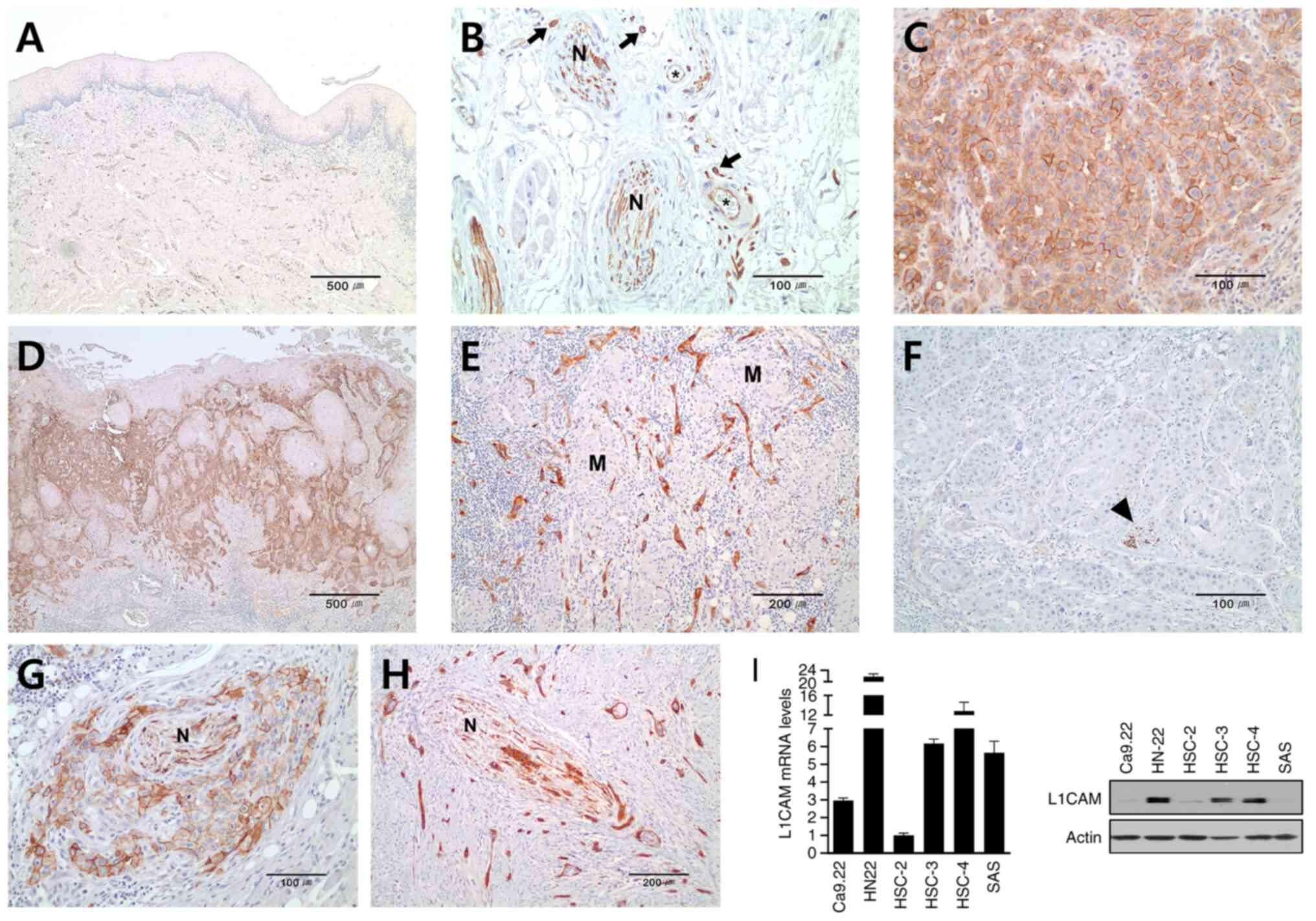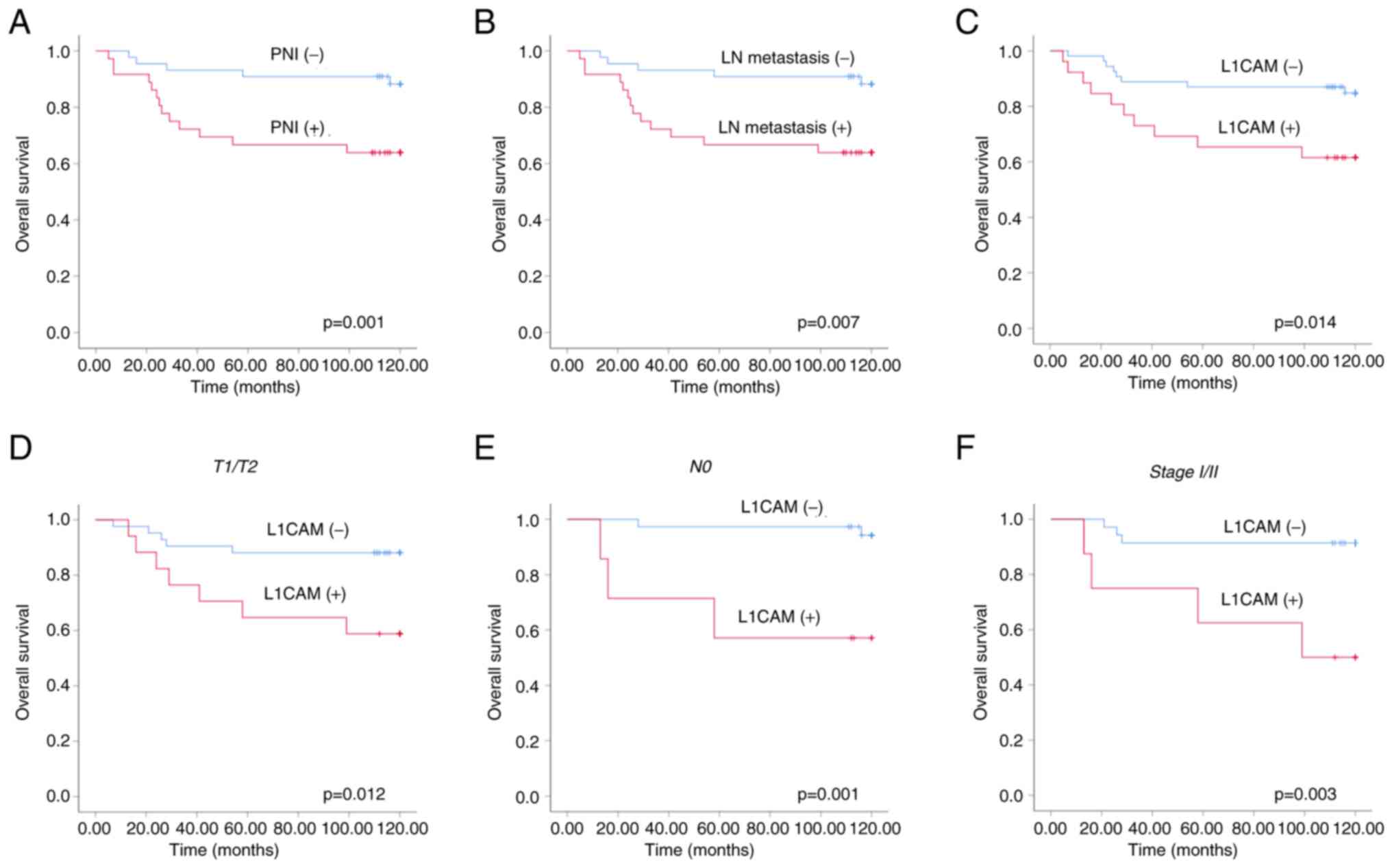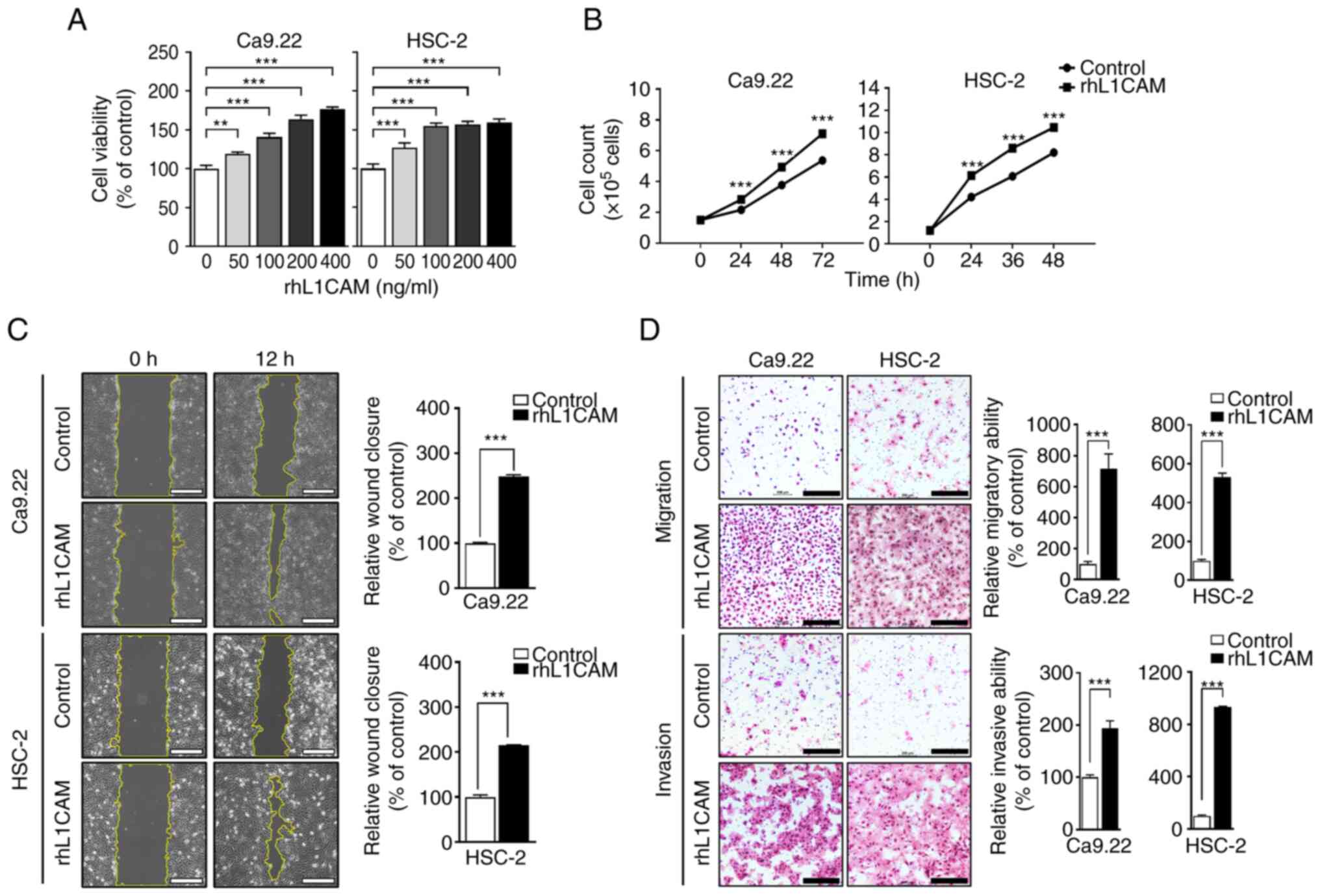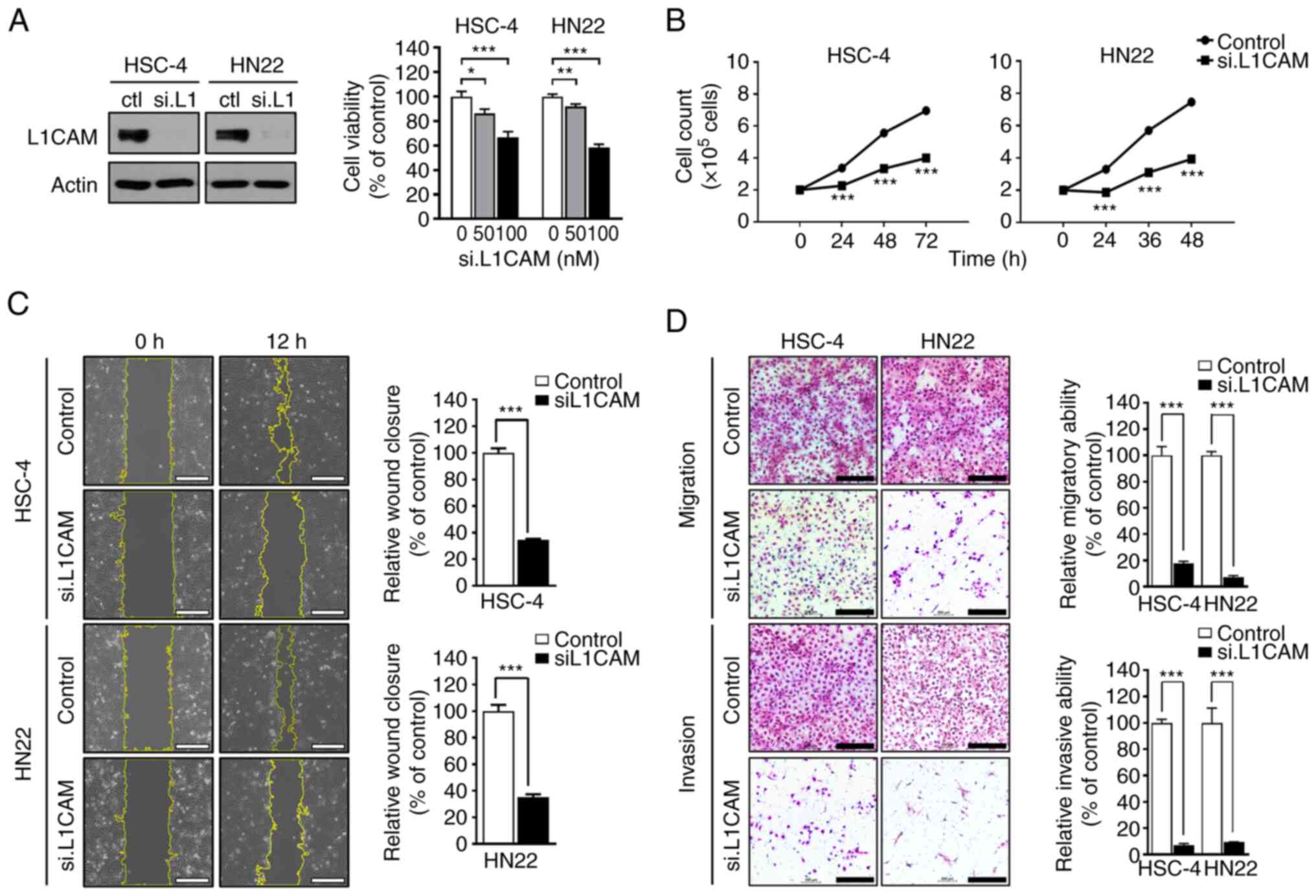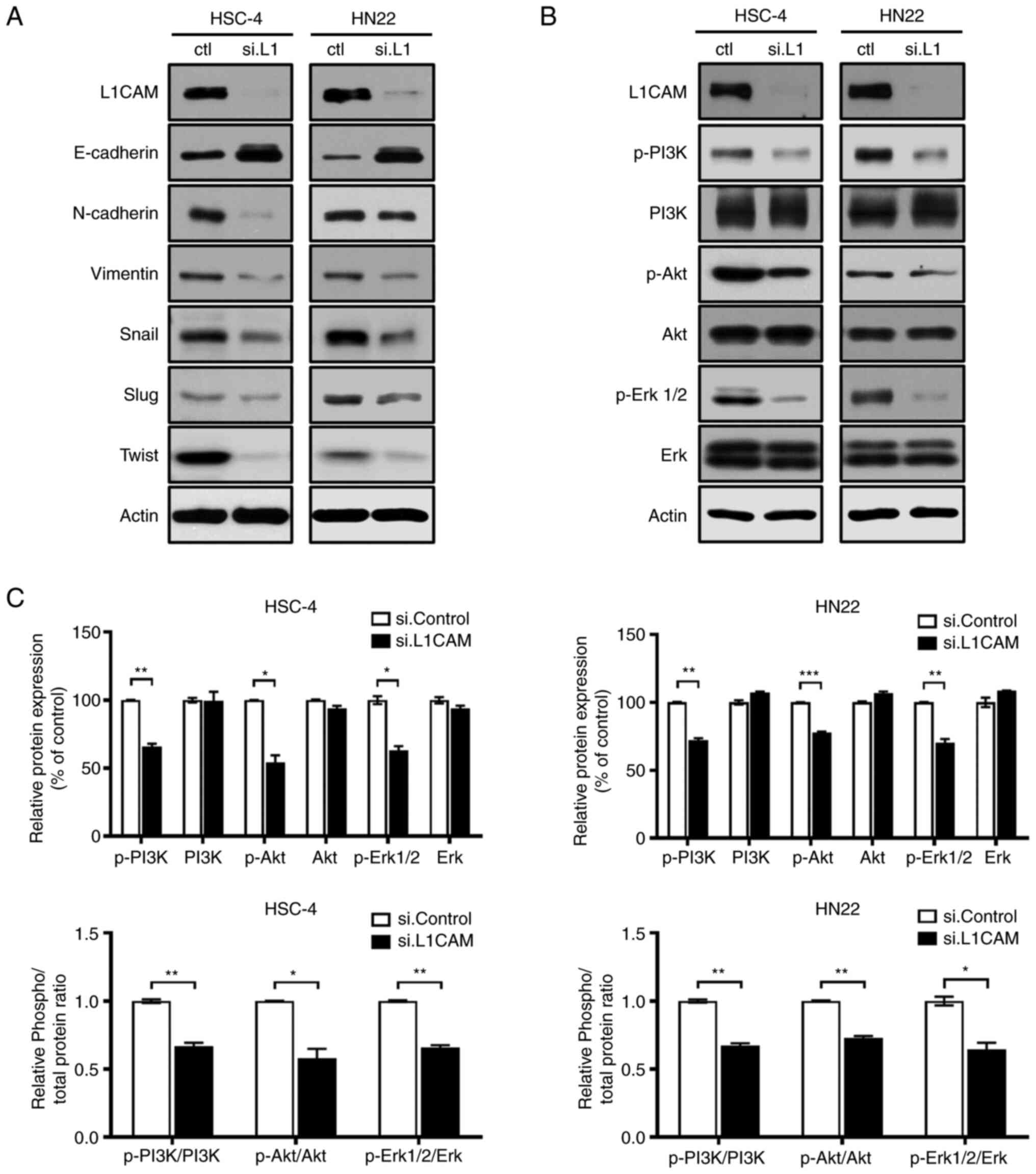|
1
|
Ferlay J, Ervik M, Lam F, Colombet M, Mery
L, Piñeros M, Znaor A, Soerjomataram I and Bray F: Global cancer
observatory: Cancer today. International Agency for Research on
Cancer; Lyon: 2020, Available from:. https://gco.iarc.fr/today
|
|
2
|
Noguti J, De Moura CF, De Jesus GP, Da
Silva VH, Hossaka TA, Oshima CT and Ribeiro DA: Metastasis from
oral cancer: an overview. Cancer Genomics Proteomics. 9:329–335.
2012.PubMed/NCBI
|
|
3
|
Liebig C, Ayala G, Wilks JA, Berger DH and
Albo D: Perineural invasion in cancer: A review of the literature.
Cancer. 115:3379–3391. 2009. View Article : Google Scholar : PubMed/NCBI
|
|
4
|
Tarsitano A, Tardio ML and Marchetti C:
Impact of perineural invasion as independent prognostic factor for
local and regional failure in oral squamous cell carcinoma. Oral
Surg Oral Med Oral Pathol Oral Radiol. 119:221–228. 2015.
View Article : Google Scholar
|
|
5
|
Schmitd LB, Scanlon CS and D'Silva NJ:
Perineural invasion in head and neck cancer. J Dent Res.
97:742–750. 2018. View Article : Google Scholar : PubMed/NCBI
|
|
6
|
Altevogt P, Doberstein K and Fogel M:
L1CAM in human cancer. Int J Cancer. 138:1565–1576. 2016.
View Article : Google Scholar : PubMed/NCBI
|
|
7
|
Kiefel H, Bondong S, Hazin J, Ridinger J,
Schirmer U, Riedle S and Altevogt P: L1CAM: A major driver for
tumor cell invasion and motility. Cell Adh Migr. 6:374–384. 2012.
View Article : Google Scholar : PubMed/NCBI
|
|
8
|
Inaguma S, Wang Z, Lasota JP and Miettinen
MM: Expression of neural cell adhesion molecule L1 (CD171) in
neuroectodermal and other tumors: An immunohistochemical study of
5155 tumors and critical evaluation of CD171 prognostic value in
gastrointestinal stromal tumors. Oncotarget. 7:55276–55289. 2016.
View Article : Google Scholar
|
|
9
|
Gschwandtner M, Paulitschke V, Mildner M,
Brunner PM, Hacker S, Eisenwort G, Sperr WR, Valent P, Gerner C and
Tschachler E: Proteome analysis identifies L1CAM/CD171 and
DPP4/CD26 as novel markers of human skin mast cells. Allergy.
72:85–97. 2017. View Article : Google Scholar : PubMed/NCBI
|
|
10
|
Thies A, Schachner M, Moll I, Berger J,
Schulze HJ, Brunner G and Schumacher U: Overexpression of the cell
adhesion molecule L1 is associated with metastasis in cutaneous
malignant melanoma. Eur J Cancer. 38:1708–1716. 2002. View Article : Google Scholar : PubMed/NCBI
|
|
11
|
Fogel M, Gutwein P, Mechtersheimer S,
Riedle S, Stoeck A, Smirnov A, Edler L, Ben-Arie A, Huszar M and
Altevogt P: L1 expression as a predictor of progression and
survival in patients with uterine and ovarian carcinomas. Lancet.
362:869–875. 2003. View Article : Google Scholar
|
|
12
|
Zeimet AG, Reimer D, Huszar M, Winterhoff
B, Puistola U, Azim SA, Müller-Holzner E, Ben-Arie A, van Kempen
LC, Petru E, et al: L1CAM in early-stage type I endometrial cancer:
results of a large multicenter evaluation. J Natl Cancer Inst.
105:1142–1150. 2013. View Article : Google Scholar
|
|
13
|
Ben QW, Wang JC, Liu J, Zhu Y, Yuan F, Yao
WY and Yuan YZ: Positive expression of L1-CAM is associated with
perineural invasion and poor outcome in pancreatic ductal
adenocarcinoma. Ann Surg Oncol. 17:2213–2221. 2010. View Article : Google Scholar
|
|
14
|
Li S, Jo YS, Lee JH, Min JK, Lee ES, Park
T, Kim JM and Hong HJ: L1 cell adhesion molecule is a novel
independent poor prognostic factor of extrahepatic
cholangiocarcinoma. Clin Cancer Res. 15:7345–7351. 2009. View Article : Google Scholar : PubMed/NCBI
|
|
15
|
Ito T, Yamada S, Tanaka C, Ito S, Murai T,
Kobayashi D, Fujii T, Nakayama G, Sugimoto H, Koike M, et al:
Overexpression of L1CAM is associated with tumor progression and
prognosis via ERK signaling in gastric cancer. Ann Surg Oncol.
21:560–568. 2014. View Article : Google Scholar
|
|
16
|
Fang QX, Zheng XC and Zhao HJ: L1CAM is
involved in lymph node metastasis via ERK1/2 signaling in
colorectal cancer. Am J Transl Res. 12:837–846. 2020.PubMed/NCBI
|
|
17
|
Min JK, Kim JM, Li S, Lee JW, Yoon H, Ryu
CJ, Jeon SH, Lee JH, Kim JY, Yoon HK, et al: L1 cell adhesion
molecule is a novel therapeutic target in intrahepatic
cholangiocarcinoma. Clin Cancer Res. 16:3571–3580. 2010. View Article : Google Scholar : PubMed/NCBI
|
|
18
|
De Luca A, Maiello MR, D'Alessio A,
Pergameno M and Normanno N: The RAS/RAF/MEK/ERK and the PI3K/AKT
signalling pathways: Role in cancer pathogenesis and implications
for therapeutic approaches. Expert Opin Ther Targets. 16 (Suppl
2):S17–S27. 2012. View Article : Google Scholar : PubMed/NCBI
|
|
19
|
Hung SC, Wu IH, Hsue SS, Liao CH, Wang HC,
Chuang PH, Sung SY and Hsieh CL: Targeting l1 cell adhesion
molecule using lentivirus-mediated short hairpin RNA interference
reverses aggressiveness of oral squamous cell carcinoma. Mol Pharm.
7:2312–2323. 2010. View Article : Google Scholar : PubMed/NCBI
|
|
20
|
Shtutman M, Levina E, Ohouo P, Baig M and
Roninson IB: Cell adhesion molecule L1 disrupts
E-cadherin-containing adherens junctions and increases scattering
and motility of MCF7 breast carcinoma cells. Cancer Res.
66:11370–11380. 2006. View Article : Google Scholar : PubMed/NCBI
|
|
21
|
Huszar M, Pfeifer M, Schirmer U, Kiefel H,
Konecny GE, Ben-Arie A, Edler L, Münch M, Müller-Holzner E,
Jerabek-Klestil S, et al: Up-regulation of L1CAM is linked to loss
of hormone receptors and E-cadherin in aggressive subtypes of
endometrial carcinomas. J Pathol. 220:551–561. 2010. View Article : Google Scholar
|
|
22
|
Tischler V, Pfeifer M, Hausladen S,
Schirmer U, Bonde AK, Kristiansen G, Sos ML, Weder W, Moch H,
Altevogt P and Soltermann A: L1CAM protein expression is associated
with poor prognosis in non-small cell lung cancer. Mol Cancer.
10:1272011. View Article : Google Scholar : PubMed/NCBI
|
|
23
|
Iwatsuki M, Mimori K, Yokobori T, Ishi H,
Beppu T, Nakamori S, Baba H and Mori M: Epithelial-mesenchymal
transition in cancer development and its clinical significance.
Cancer Sci. 101:293–299. 2010. View Article : Google Scholar
|
|
24
|
Livak KJ and Schmittgen TD: Analysis of
relative gene expression data using real-time quantitative PCR and
the 2(−Delta Delta C(T)) method. Methods. 25:402–408. 2001.
View Article : Google Scholar : PubMed/NCBI
|
|
25
|
Martinotti S and Ranzato E: Scratch wound
healing assay. Methods Mol Biol. 2109:225–229. 2020. View Article : Google Scholar
|
|
26
|
Chen DL, Zeng ZL, Yang J, Ren C, Wang DS,
Wu WJ and Xu RH: L1cam promotes tumor progression and metastasis
and is an independent unfavorable prognostic factor in gastric
cancer. J Hematol Oncol. 6:432013. View Article : Google Scholar
|
|
27
|
Adnan Y, Ali SMA, Farooqui HA, Kayani HA,
Idrees R and Awan MS: High CD44 immunoexpression correlates with
poor overall survival: Assessing the role of cancer stem cell
markers in oral squamous cell carcinoma patients from the high-risk
population of Pakistan. Int J Surg Oncol. 2022:99904892022.
|
|
28
|
Kommoss FK, Karnezis AN, Kommoss F,
Talhouk A, Taran FA, Staebler A, Gilks CB, Huntsman DG, Krämer B,
Brucker SY, et al: L1CAM further stratifies endometrial carcinoma
patients with no specific molecular risk profile. Br J Cancer.
119:480–486. 2018. View Article : Google Scholar : PubMed/NCBI
|
|
29
|
Abdelrahman AE, Salem A, Al Attar AZ,
Elsebai E, Samy W, Ibrahim MA and Ibrahim HM: p53, Pirh2, and L1CAM
as promising prognostic biomarkers of endometrial carcinoma: An
immunohistochemical and genetic study. Appl Immunohistochem Mol
Morphol. 30:713–725. 2022. View Article : Google Scholar
|
|
30
|
Amit M, Na'ara S and Gil Z: Mechanisms of
cancer dissemination along nerves. Nat Rev Cancer. 16:399–408.
2016. View Article : Google Scholar : PubMed/NCBI
|
|
31
|
Shen WR, Wang YP, Chang JY, Yu SY, Chen HM
and Chiang CP: Perineural invasion and expression of nerve growth
factor can predict the progression and prognosis of oral tongue
squamous cell carcinoma. J Oral Pathol Med. 43:258–264. 2014.
View Article : Google Scholar : PubMed/NCBI
|
|
32
|
Tai SK, Li WY, Chu PY, Chang SY, Tsai TL,
Wang YF and Huang JL: Risks and clinical implications of perineural
invasion in T1-2 oral tongue squamous cell carcinoma. Head Neck.
34:994–1001. 2012. View Article : Google Scholar : PubMed/NCBI
|
|
33
|
Chinn SB, Spector ME, Bellile EL, McHugh
JB, Gernon TJ, Bradford CR, Wolf GT, Eisbruch A and Chepeha DB:
Impact of perineural invasion in the pathologically N0 neck in oral
cavity squamous cell carcinoma. Otolaryngol Head Neck Surg.
149:893–899. 2013. View Article : Google Scholar : PubMed/NCBI
|
|
34
|
Tsutsumi S, Morohashi S, Kudo Y, Akasaka
H, Ogasawara H, Ono M, Takasugi K, Ishido K, Hakamada K and Kijima
H: L1 cell adhesion molecule (L1CAM) expression at the cancer
invasive front is a novel prognostic marker of pancreatic ductal
adenocarcinoma. J Surg Oncol. 103:669–673. 2011. View Article : Google Scholar
|
|
35
|
Kajiwara Y, Ueno H, Hashiguchi Y, Shinto
E, Shimazaki H, Mochizuki H and Hase K: Expression of l1 cell
adhesion molecule and morphologic features at the invasive front of
colorectal cancer. Am J Clin Pathol. 136:138–144. 2011. View Article : Google Scholar
|
|
36
|
Na'ara S, Amit M and Gil Z: L1CAM induces
perineural invasion of pancreas cancer cells by upregulation of
metalloproteinase expression. Oncogene. 38:596–608. 2019.
View Article : Google Scholar
|
|
37
|
Guo JC, Xie YM, Ran LQ, Cao HH, Sun C, Wu
JY, Wu ZY, Liao LD, Zhao WJ, Fang WK, et al: L1CAM drives
oncogenicity in esophageal squamous cell carcinoma by stimulation
of ezrin transcription. J Mol Med (Berl). 95:1355–1368. 2017.
View Article : Google Scholar : PubMed/NCBI
|
|
38
|
Silletti S, Yebra M, Perez B, Cirulli V,
McMahon M and Montgomery AMP: Extracellular signal-regulated kinase
(ERK)-dependent gene expression contributes to L1 cell adhesion
molecule-dependent motility and invasion. J Biol Chem.
279:28880–28888. 2004. View Article : Google Scholar : PubMed/NCBI
|
|
39
|
Arlt MJE, Novak-Hofer I, Gast D, Gschwend
V, Moldenhauer G, Grünberg J, Honer M, Schubiger PA, Altevogt P and
Krüger A: Efficient inhibition of intra-peritoneal tumor growth and
dissemination of human ovarian carcinoma cells in nude mice by
anti-L1-cell adhesion molecule monoclonal antibody treatment.
Cancer Res. 66:936–943. 2006. View Article : Google Scholar : PubMed/NCBI
|
|
40
|
Schäfer H, Dieckmann C, Korniienko O,
Moldenhauer G, Kiefel H, Salnikov A, Krüger A, Altevogt P and
Sebens S: Combined treatment of L1CAM antibodies and cytostatic
drugs improve the therapeutic response of pancreatic and ovarian
carcinoma. Cancer Lett. 319:66–82. 2012. View Article : Google Scholar
|
|
41
|
Sung SY, Wu IH, Chuang PH, Petros JA, Wu
HC, Zeng HJ, Huang WC, Chung LW and Hsieh CL: Targeting L1 cell
adhesion molecule expression using liposome-encapsulated siRNA
suppresses prostate cancer bone metastasis and growth. Oncotarget.
5:9911–9929. 2014. View Article : Google Scholar
|















